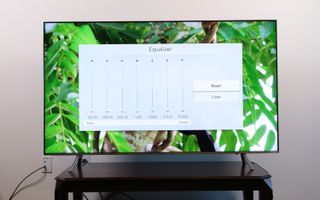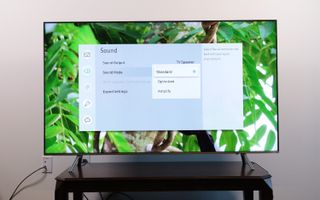Samsung TV 2018 Settings Guide: What to Enable, Disable and Tweak
We walk you through the menus and features of Samsung's 2018 TVs so you can outsmart your new smart TV.
How to Adjust the Audio Settings on 2018 Samsung TVs
TV is an audiovisual experience, and your ears account for half of that experience. Keep your ears happy by adjusting the audio settings on the TV to get the best sound quality you can. If you have trouble hearing whispered dialogue or bass drowns out other audio whenever things get loud, you can solve most of those problems in the audio settings.
As with adjusting the display, there are two methods for accessing audio settings.

1. Open the Quick Settings for audio presets. The first method is to use the Quick Settings on the home screen. Navigate all the way to the left, to the Settings tab, and up to the top row of the menu. Select Sound, and hit Enter. Here, you can cycle through several sound modes, with preset audio profiles for Standard, Optimized and Amplify.

2. Get more control in the Audio Settings. For more granular audio control, press up on the remote to open the Equalizer Setup. Here, you can adjust the levels for specific frequency bands, letting you boost or cut the signal strength for each.

3. Select a preset. In this menu, you can cycle through the same audio presets seen in the Quick Settings, or select Expert Settings to get an extensive list of customization options: Balance, Equalizer, Audio Delay and more.

4. Adjust specific settings. In the Expert Settings, you can not only adjust the balance and specific frequencies in the equalizer but also change the preferred format of HDMI audio, select the digital audio format (including Dolby Digital Plus), change the delay between audio and video tracks when using Optical SPDIF output, and turn automatic volume leveling on and off.
With the sound tuned to your home and your ears, you should be hearing movies and music better than ever.
Current page: How to Adjust the Audio Settings on 2018 Samsung TVs
Prev Page How to Turn HDR On and Off on 2018 Samsung TVs Next Page How to Turn Off or Adjust Sound Feedback on 2018 Samsung TVsSign up to get the BEST of Tom’s Guide direct to your inbox.
Upgrade your life with a daily dose of the biggest tech news, lifestyle hacks and our curated analysis. Be the first to know about cutting-edge gadgets and the hottest deals.
Brian Westover is currently Lead Analyst, PCs and Hardware at PCMag. Until recently, however, he was Senior Editor at Tom's Guide, where he led the site's TV coverage for several years, reviewing scores of sets and writing about everything from 8K to HDR to HDMI 2.1. He also put his computing knowledge to good use by reviewing many PCs and Mac devices, and also led our router and home networking coverage. Prior to joining Tom's Guide, he wrote for TopTenReviews and PCMag.

